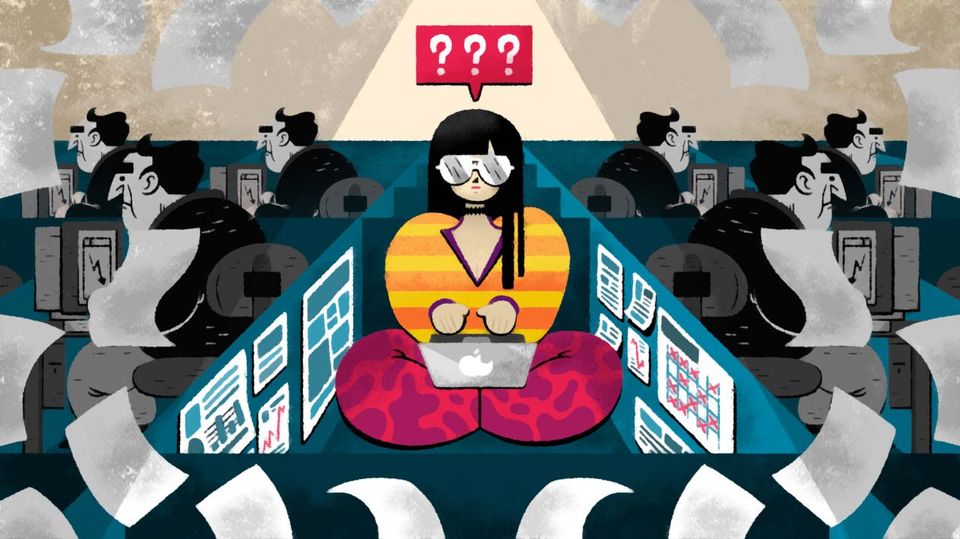Artist Spotlight: Dennie Bright
February 18, 2020
Everyone’s work is deeply idiosyncratic: in our regular Spotlight segment we explore artists’ experiences and inspiration to understand what defines and inspires their unique styles.
Can you give us a brief background on yourself?
I learned pretty early in my life that I conveyed my self best through imagery and drawing. I would almost always get flustered trying to explain something and just end up saying, “Let me just draw you what I’m trying to say.” I went to the Huntington School of Fine Art during my high school days and ended up going to The School of The Art Institute of Chicago for college. I studied Animation and Illustration, mostly 3D, but after college I fell back into 2D and mostly illustration. I’ve done work for The Huffington Post, Mashable, and currently I’m venturing into VR illustration at my own studio TwoThumbs. I tried VR a couple years ago, and since then it’s completely grabbed ahold of me.
What kind of influence does your location have on your career?
Being in New York you see so many different people while commuting. Everyone is so different and I constantly find myself thinking, I need to draw this person, or use their style on a character design I’m trying to develop. Everything’s constantly changing here too, so there’s some place new to always explore and things to experience.

What is your greatest source of inspiration?
Disney and Looney Tunes. Most people my age had cable television growing up, so they were exposed to Nickelodeon really early. All I had was old VHS tapes of really classic Disney and Looney Tunes cartoons. I would just watch the same ones over and over. Nothing beats a classic cartoon smear.
Could you pick one piece of art that has made a lasting influence on you, and if so why?
The animated short Destino, which is Disney & Salvador Dali's piece that was finished in 2003. I love the abstract and surrealness of Dali's paintings, and the animated short is like watching his work come to life. I rewatch it every now and then, it always inspires me to push the limits of what I can think and do.
What skills or techniques do you find most useful in your line of work? Do you use primarily traditional or digital methods to create your artwork?
In my experience the more you learn, the different mediums and styles, the better you will grow as an artist. Traditional work helped me when moving over to a digital medium, and having actually done sculpture, helped me when I wanted to learn sculpting in 3D. My advice is to never say no, and always try to learn as much as you can. Be a jack of all trades and a master at them too.
Can you give our readers a tip or trick you have come across that has made your work a lot easier?
It's not so much a tip or trick as it is a mantra that you should live by, "Draw every day." If you want to grow and become a better artist, keeping up with your craft and drawing each day will make you that much better. Figure drawing also helped me a lot with working with a time limit and drawing from life.
How can people who are interested in discovering more of your work find it?
You can find me at
twitter: twitter.com/denniebright
facebook: facebook.com/dennie.bright
instagram: instagram.com/dennie.bright
linkedin: linkedin.com/in/denniebright
and on my website: denniebright.com
Scriba is a revolutionary digital stylus that is ergonomically designed to comfortably fit your hand and uses unique Squeeze-Motion technology. Order here.
Articles

In the period since COVID forced many of us back home and out of the office, remote work has become the new norm for many. The flexibility of working from home, especially for those with small children, is very compelling, but making a productive workspace is more than setting up a desk in the spare room. More people are seeking to create functional and comfortable workspaces in their homes, however, it can be difficult to strike the right balance between a professional office space and a cosy home environment. Here are some tips for designing a home workspace that meets both of these needs: Dedicate a specific area for work Designating a specific area for work is essential for separating work from leisure time. This could be a separate room or just a corner of a room. It is important to make sure that the workspace is free from distractions and clutter, as this will help you stay focused and productive. Choose the right furniture Ergonomic furniture is key to a comfortable and productive workspace. Invest in a comfortable chair, a desk that is the right height, and a good-quality mouse and keyboard. If you are prone to back pain, consider a standing desk. Add personal touches Just because your workspace should be functional, doesn’t mean it can’t be personal. Add photos, plants, and other personal items to make the space feel like your own. This will help create a sense of comfort and make you feel at home in your workspace. Good lighting Good lighting is essential for a comfortable workspace. If possible, place your desk near a window for natural light. If not, invest in a high-quality desk lamp to provide bright, even light. Keep it organised An organised workspace will help you stay productive and focused. Use desk organisers, filing cabinets, and other tools to keep your work area free from clutter. A clean and organised workspace will also help you start each day with a clear mind. Consider your work style Think about the type of work you do and how you like to work. If you prefer a minimalist workspace, opt for a simple desk and a few basic supplies. If you need space for multiple screens and other technology, make sure you have enough room to work comfortably. Take breaks It’s important to take breaks throughout the day to avoid burnout. Step away from your desk, go for a walk, or do some stretching exercises to clear your mind and recharge.











